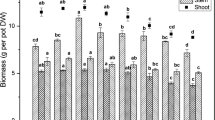Abstract
The release of elemental selenium on the root surface of maize (Zea mays L., variety Krasnodarskii 29/AMV) seedlings observed in response to the addition of selenium-organic preparation DAFS-25 (diacetophenonyl selenide) to the nutrient Knop solution and accompanied by inhibition of growth of the roots was investigated. This process was completely suppressed after the addition of cysteine to the above solution containing 10–2 g/L DAFS-25, with the inhibiting effect was attenuated as well. In addition, DAFS-25 exerted impact on nitrogen exchange in the plants as judged by elevating the protein fraction of albumins in the roots almost by a factor of two due to at the expense of decreasing the content of glutelin, prolamine, and globulin fractions by 43, 25, and 26%, respectively. In the case of the action of DAFS-25 in combination with cysteine the quantitative composition of the above proteins very closely resembled that of the control plants indicating that cysteine behaves as antidote. It was found that DAFS-25 exerted a similar action on the content of albumins in the above-ground part of maize seedlings where this value drastically increased (by a factor of 4.5) on the background of total protein content elevation. In addition, this preparation at the highest concentration tested stimulated the activity of peroxidase in both the roots (by 63%) and the above-ground part of seedlings (by 112%). However, this effect of DAFS-25 was strongly inhibited after addition of cysteine to the nutrient solution. Evaluation of selenium content in the same parts of the control seedlings showed that they contain only a little amount of this element. The highest content of selenium in the above plant tissues was found after addition of DAFS-25 to the nutrient solution that provides evidence for its decomposition directly on the surface of the roots. Such an action of DAFS-25, like its impact on the peroxidase activity, was markedly attenuated in the presence of cysteine.
Similar content being viewed by others
Abbreviations
- DAFS-25:
-
1,5-diphenyl-3-seleniumpentadione 1,5 (diacetofenonyl selenide)
References
Blinokhvatov, A.F., 9-R-sim nonahydro-10-oxa(chalcogen) anthracene and salts of 9-R-sim-oktahydro-10-oxonium(chalcogenon) anthracene, Doctoral (Chem.) Dissertation, Saratov: Sarat. Gos. Univ., 1993.
Golubkina, N.A., Investigation of the medicinal plants role in the selenium status formation of the population in Russia, Doctoral (Agric.) Dissertation, Moscow: Ros. Akad. Med. Nauk, 1999.
Kabata-Pendias, S., Mikroelementy v pochvakh i rasteniyakh (Trace Elements in Soils and Plants), Boca Raton, FL: CRC Press, 2010.
Toroshin, S.P., Yagodin, B.A., and Udel’nova, T.M., Accumulation of selenium in spring wheat and spring rape fertilized by selenium, zinc, molybdenum, and sulfur, Agrokhimiya, 1996, no. 5, pp. 54–63.
Postnikov, A.V. and Illarionova, E.S., Novoe v ispol’zovanii selena v zemledelii (New Approaches to the Use of Selenium in Agriculture), Moscow: Vseros. Akad. S.-kh. Nauk, 1991.
Toroshin, S.P., Udel’nova, T.M., and Yagodin, B.A., Biogeochemistry and agricultural chemistry of selenium and methods for eliminating of selenium deficiency in food and feed. Review, Agrokhimiya, 1996, no. 8–9, pp. 127–140.
Ermakov, V.V. and Koval’skii, V.V., Biologicheskoe znachenie selena (The Biological Significance of Selenium), Moscow: Nauka, 1974.
Girling, C.A., Selenium in agriculture and the environment. Review, Agric. Ecosyst. Environ., 1984, vol. 11, pp. 37–65.
Albasel, N., Pratt, P.F., and Westeot, D.W., Guidelines for selenium in irrigation waters, Environ. Qual., 1989, vol. 18, pp. 253–259.
Drevko, B.I., An agent for treating and preventing diseases caused by selenium deficiency in the body of agricultural animals and birds, RF Patent no. 2051681, Byull. Izobret., 2001, no. 1.
Vikhreva, V.A., Ecological and agrochemical aspects of selenium use for crops and goat’s rue on the black earth of the Middle Volga steppe, Extended Abstr. Doctoral (Biol.) Dissertation, Vladimir: Vladim. Gos. Univ., 2011.
Davidchuk, N.V., Responses of Galega orientalis plants to DAFS-25, Usp. Sovrem. Estestvoznaniya, 2005, no. 11, pp. 47–48.
Poluboyarinov, P.A., Vikhreva, V.A., Leshchenko, P.P., Aripovskii, A.V., and Likhachev, A.N., Elemental selenium formation upon destruction of the organoselenium compound DAFS-25 molecule by growing fungal mycelium, Moscow: Univ. Biol. Sci. Bull., 2009, vol. 64, no. 4, pp. 164–168.
Poluboyarinov, P.A. and Leshchenko, P.P., Qualitative reaction to cysteine, reduced glutathione, and diacetyl benzophenone selenide, Zh. Anal. Khim., 2013, vol. 68, p. 1063.
Dudka, I.A. and Vasser, S.P., Metody eksperimental’noi mikologii. Spravochnik (Methods of Experimental Mycology. Handbook), Kiev: Nauk. Dumka, 1982.
Mineev, V.G., Sychev, V.G., Amel’yanchik, O.A., Bolysheva, T.N., Gomonova, N.F., Durynina, E.P., Egorov, B.C., Egorova, E.V., Edemskaya, N.L., Karpova, E.A., and Prizhukova, V.G., Praktikum po agrokhimii (Practical Guide for Agricultural Chemistry), Moscow: Mosk. Gos. Univ., 2001.
Bradford, M.M., A rapid and sensitive method for the quantitation of microgram quantities of protein utilizing the principle of protein–dye binding, Anal. Biochem., 1976, vol. 72, pp. 248–254.
Nazarenko, I.I. and Ermakov, A.N., Analiticheskaya khimiya selena i tellura (Analytical Chemistry of Selenium and Tellurium), Moscow: Nauka, 1971.
Gavrilenko, V.F., Ladygina, M.E., and Khandobina, L.M., Bol’shoi praktikum po fiziologii rastenii. Fotosintez. Dykhanie (Handbook for Plant Physiology. Photosynthesis. Respiration), Rubin, B.A., Ed., Moscow: Vyssh. Shk., 1975.
Opredelenie selena v produktakh pitaniya. Metodicheskie ukazaniya. MUK 4.1.033–95 (Determination of Selenium in Foods. Guidelines), Moscow: Informatsionno-zdatel’skii Tsentr Goskomsanepidnadzora Rossii, 1995.
Yoshida, M. and Yokimoto, M., Effects of fungicides on channels in the fungal membrane, Pestic. Biochem. Physiol., 1993, vol. 47, pp. 171–177.
Peyroche, G., Saveanu, C., Dauplais, M., Lazard, M., Beuneu, F., Decourty, L., Malabat, C., Jacquier, A., Blanquet, S., and Plateau, P., Sodium selenide toxicity is mediated by O2-dependent DNA breaks, PLoS ONE, 2012, vol. 7 (5): e36343.
Author information
Authors and Affiliations
Corresponding author
Rights and permissions
About this article
Cite this article
Poluboyarinov, P.A., Golubkina, N.A. Investigation of biochemical function of selenium and its influence on the content of protein fractions and peroxidase activity in maize seedlings. Russ J Plant Physiol 62, 367–374 (2015). https://doi.org/10.1134/S1021443715030164
Received:
Published:
Issue Date:
DOI: https://doi.org/10.1134/S1021443715030164




